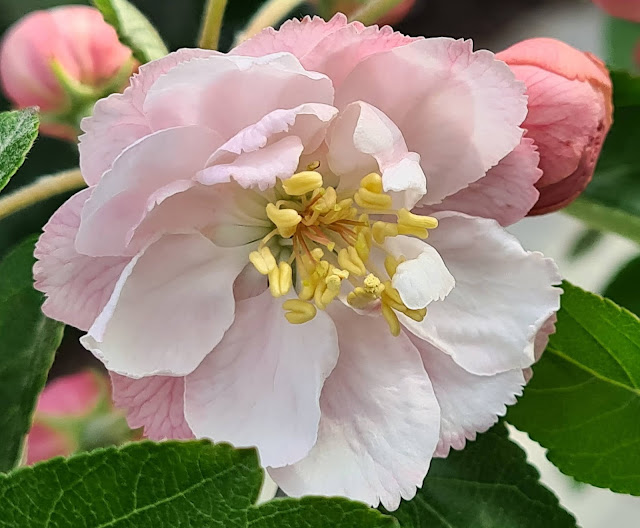Crab Apple bears little malus
This, I understand, is not the origin of the botanical name for the apple genus, Malus. That comes from a similarly spelt word used for the apple tree, with the term 'malum' used for its fruit. Maybe there is a shared origin behind its first use to describe an apple. But don't be fooled by the biblical reference to an 'apple' in the story of Adam and Eve, which most likely refers to a fig.
My images today are of a crabapple, which I'll get to shortly. The scientific naming of cultivated apples - crab and otherwise - began with Swedish botanist Carl Linnaeus. In his nomenclature-starting publication of 1753, he included pears, apples and quinces all in his genus Pyrus, a name we now confined to pears.
The apples were included in one of six varieties of Pyrus malus. Botanist and chief gardener at Chelsea Physic Garden in London, Philip Miller, very quickly (a year later) separated the apples into their own genus, Malus.
Then things get messy and for the purposes of this post, let's just say that the domestic apple is now called Malus domestica, a name described in 1803 by German naturalist Moritz Balthasar Borkhausen, but formally 'conserved' in 2017, at the Botanical Congress held in Shenzhen, China. I attended that congress, but not the nomenclatural sessions on apples. This name now replaces names such as Malus pumila, which were previously considered to have priority over this name.
Now, crabapple is a name applied to apple cultivars escaping from cultivation or specially bred cultivars or hybrids, particularly for their flowers. Confusingly, it is also used for members of the related genus, Crataegus.
Most crabapples are sour-fruited. But why 'crab'? That seems to be either from an old nordic word for apple (in Swedish, skrabba, is used for the fruit of a wild apple tree in Swedish) or from 'crabbed', as in a crooked gait like a crab and used to describe disagreeable things - such as the fruit of the crab apple. There are other options out there if you need them.
In this next photograph you can see by the stipules - those wispy brown filaments - on the leaf stalks, and the usually five petals (but see below) around a cluster of stamens in the flowers, that this is a member of the Rosaceae family.
Then from its eventual fruit, a pome (yes, as in the French word for apple), that it is something like a Malus (apple) or Pyrus (pear).
And finally, from the fine detail of the flower - its female bits, the styles, are united at the base - you can narrow in on Malus. Of course the texture fruit is distinctive, despite some pears being bred to be like apples (I'm thinking of you nashi).
Now we are amongst the apples, the leaf shape and indumentum, and the rather attractive soft-pink flowers, place it within a North American species, the Prairie Crabapple, Malus ioensis.
Nearly there...
As a prize for getting this far, do enjoy this etching of the species (not the cultivar). It's from a lithograph by J.N. Fitch, first published in Curtis's Botanical Magazine volume 139, plate 8488, in 1913. It's rather pretty. As is the Bechtel Crab in our backyard. Despite the name.
Thank you Neville Walsh for suggesting the ambiguous etymology of Malus, which, as always, led to other things.





Comments